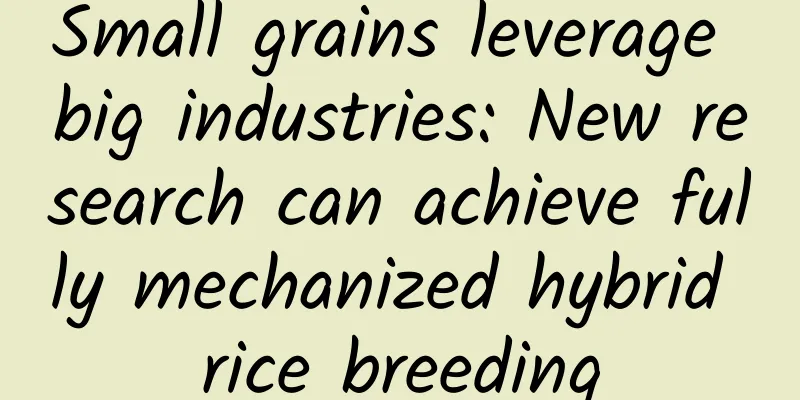Small grains leverage big industries: New research can achieve fully mechanized hybrid rice breeding

|
The public is familiar with hybrid rice, but few people know that hybrid rice seed production has been highly dependent on manual labor, and rice seed production is still a labor-intensive industry. The new results of Chinese scientists may completely change this situation and pave the way for mechanized seed production. Written by Huang Ke and Li Yunhai On June 3, Nature Plants published online a paper by a Chinese research team titled "Modulation of histone acetylation enables fully mechanized hybrid rice breeding." Some comments said that "this achievement will completely change the rules of the game in the hybrid rice seed production industry." As the co-first author and corresponding author of this paper, I am very willing to share with you the background, process and significance of this achievement. Hybrid breeding is still a labor-intensive industry Heterosis (hybrid vigor) refers to the phenomenon that a hybrid is superior to both parents in one or more traits. For example, the hybrids obtained by crossbreeding different strains, varieties, or even species often show stronger growth rates and metabolic functions than their parents, resulting in increased yield or biomass, or enhanced adaptability and resistance to biotic and abiotic stresses. This is a common phenomenon in the biological world. Figure: Hybrid vigor in corn and rice The utilization of hybrid vigor depends on the large-scale production of hybrid seeds, and rice is a monoecious, self-pollinating crop. In 1966, Yuan Longping published a paper entitled "Male Sterility in Rice", which formally proposed to utilize the hybrid vigor of rice and mass-produce hybrid rice seeds by cultivating the "three lines" of rice, namely the male sterile line, the maintainer line and the restorer line, with the "three-line matching" method. The main design idea is to use the plant with male sterility caused by cytoplasmic gene mutation as the female parent (male sterile line) and the fertile plant (maintainer line) with the nuclear gene exactly the same as the male sterile line but different cytoplasmic genes as the male parent for hybridization to achieve the reproduction of male sterile line seeds; then use the fertile plant that can restore the pollen fertility of the F1 plant as the male parent (restorer line) for hybridization with the male sterile line to produce hybrid seeds with hybrid vigor. In 1973, with the joint cooperation of a large number of rice breeders represented by Yuan Longping, China's indica hybrid rice "three-line" was successfully matched and began commercialization in 1976. In 1981, Shi Mingsong proposed the concept of "dual-purpose sterile line", that is, it shows complete male sterility under specific light and temperature conditions, can be used as a female parent to hybridize with the restorer line to produce hybrid seeds, and is fertile under other light and temperature conditions and can achieve self-reproduction. The "two-line method" eliminates the maintenance line in the "three-line method", simplifies the hybrid rice breeding process and seed production procedures, and has obvious advantages in hybrid rice breeding. In 1995, two-line hybrid rice varieties began to be widely promoted and applied in China. The promotion of hybrid rice has increased China's rice yield per unit area by 20%-30%, greatly ensuring food security. Figure: Principles of the “three-system method” and the “two-system method” Hybrid rice has been widely used in China for nearly 50 years, and hybrid rice varieties have been continuously iterating to achieve higher yields and better quality. However, whether it is the "three-line method" or the "two-line method", the large-scale planting of hybrid rice depends on the large-scale production of hybrid seeds. However, the production process (seed production) of hybrid seeds is extremely cumbersome, time-consuming and labor-intensive, and is a labor-intensive industry. The traditional hybrid rice seed production process mainly includes: the staggered planting of male parents (restorer lines) and female parents (sterile lines), usually 1-2 rows of male parents corresponding to 6-10 rows of female parents to provide sufficient pollen; artificial pollination when the male and female parents are flowering to increase the fruit set rate of the female parent; timely manual removal of the male parent in the field after the pollination of the female parent is completed to prevent the restorer line seeds from contaminating the hybrid seeds; and harvesting the hybrid seeds after the female parents mature. Therefore, the traditional hybrid rice seed production process is intensive farming and highly dependent on manual labor. In the past nearly 50 years, the production of hybrid seeds has always followed this model, with few major breakthroughs. However, with the continuous rise in labor costs, the cost of hybrid rice seed production has also continued to increase, which has also increased the cost of farmers' seed use and reduced the economic benefits of hybrid rice cultivation. At the same time, with the development of the economy and the advent of an aging population, there are fewer and fewer industrial workers of the right age who can engage in the rice seed production industry. Therefore, it is urgent to develop a seed production method suitable for hybrid rice mechanization to achieve industrial upgrading of hybrid rice seed production. Figure: Traditional seed production model Searching for the ideal gene regulating grain size In recent decades, rice breeders have proposed several strategies for mechanized seed production, including: (1) utilizing the difference in husk color between male sterile lines and restorer lines to separate hybrid seeds from mixed seeds using specific photoelectric color sorting equipment; (2) introducing herbicide-sensitive genes into restorer lines, or introducing herbicide-resistant genes into male sterile lines, and removing restorer lines from the field by spraying herbicides after pollination; (3) using female sterile restorer lines to pollinate male sterile lines to produce hybrid seeds. Female sterile restorer lines do not self-pollinate, so there is no need to remove restorer line seeds. These methods all have certain technical defects, or due to the lack of high-quality genetic resources, the breeding cycle of related varieties is too long, so they have not yet been applied on a large scale. In addition, a very promising and simple method is to plant sterile lines and restorer lines together, and use the difference in seed size between sterile lines and restorer lines to mechanically sort hybrid seeds and restorer seeds through sieves. What is being done now is to cultivate small-grain sterile lines through traditional breeding methods, and combine them with large-grain restorer lines to mechanically sort rice hybrid seeds. However, this method has only been tried a few times so far and has not been applied on a large scale in hybrid rice seed production. Traditional breeding methods also make it difficult to quickly improve existing varieties to adapt to the mechanized seed production of hybrid rice. The difficulty and core of using grain size regulatory genes for mechanized hybrid seed production is to find the ideal grain size regulatory genes and cultivate ideal small-grain sterile lines. The ideal grain size gene functional loss mutation should significantly reduce grain size (especially grain thickness); the recessive mutation of this gene leads to small grains, affecting grain size through the maternal parent; it does not affect important agronomic traits such as plant height, panicle type, and flowering time. At the same time, the small-grain sterile line should not have a negative impact on the number of F1 hybrids and hybrid rice yield. So far, although it has been found that the functional loss of many genes will cause rice grains to become smaller, it will also have a negative impact on other agronomic traits. Therefore, it is urgent to find the ideal grain size regulatory gene and cultivate a small-grain sterile line suitable for mechanized seed production. Figure: Schematic diagram of mechanized seed production using the difference in seed size between sterile lines and restorer lines Realizing industrial upgrading of hybrid rice seed production In order to find the ideal grain size regulating gene and quickly cultivate/improve new hybrid rice varieties suitable for mechanized seed production, we cooperated with the teams of Zhu Xudong and Wang Yuexing from the China National Rice Research Institute, Wang Dekai from Zhejiang Sci-Tech University, and Luo Yuehua from Hainan University to cultivate ideal small-grain sterile lines/maintenance lines and explore ideal small-grain genes through two strategies. One is to use small-grain rice varieties as donor parents, select ideal small-grain sterile lines/maintenance lines through traditional breeding methods, and further clone potential ideal small-grain genes; the second is to find ideal small-grain mutants through genetic mutagenesis screening, clone ideal small-grain genes, and then cultivate ideal small-grain sterile lines through molecular design breeding. Both methods are like looking for a needle in a haystack and are extremely difficult. We first improved the parents of Tianyou Huazhan through traditional breeding methods to cultivate ideal sterile lines/maintainer lines to meet the needs of mechanized seed production. Tianyou Huazhan is a high-yield and high-quality three-line hybrid indica rice variety, which has been promoted and planted for more than 30 million mu. Its sterile lines, maintainer lines and restorer lines are Tianfeng A, Tianfeng B and Huazhan respectively. We selected a series of small-grain materials as donor parents to hybridize with Tianfeng B (the maintainer line of the three-line hybrid rice Tianyou Huazhan). In the end, only the small-grain rice variety XLG was successfully hybridized with Tianfeng B, and the ideal small-grain maintainer line Xiaoqiao B (XQB) and the corresponding ideal small-grain sterile line Xiaoqiao A (XQA) were cultivated. The number of panicles and tillers of Xiaoqiao A and Xiaoqiao B plants also increased significantly. At the same time, we hybridized the large-grain rice variety Kuangsijiadi with Huazhan to cultivate a new large-grain restorer line, Dali Huazhan (DHZ). Field trials showed that Xiaoqiao A and the large-grain restorer line can achieve mechanized seed production of hybrid rice. Due to the increase in the number of panicles and tillers of Xiaoqiao A, the number of hybrid seeds per unit seed production area increased by about 20%. Field experiments showed that the yield of hybrid rice produced by the combination of Xiaoqiao A and Dali Huazhan was not significantly different from that of the control group. In order to find the ideal small-grain gene in Xiaoqiao A and Xiaoqiao B, we crossed Xiaoqiao B with ZH11 (a japonica rice variety with complete genome information and high genetic transformation efficiency), located a major effect locus GSE3 affecting seed size on chromosome 3, and finally identified the GSE3 gene through QTL Mapping and MutMap methods. GSE3 encodes a GCN5-related N-acetyltransferase that can affect histone acetylation levels. In Xiaoqiao A, Xiaoqiao B and XLG varieties, there is a 10bp sequence deletion in the third exon of the GSE3 gene, resulting in the loss of GSE3 protein function. At the same time, we have also conducted large-scale mutagenesis screening for more than a decade to find ideal small-grain mutants to cultivate ideal small-grain sterile lines/maintainer lines. We screened hundreds of mutants with smaller grains, but most of them had defects in some key agronomic traits, such as short plants, smaller panicles, reduced tiller numbers and number of grains per panicle, and smaller leaves. Fortunately, we identified a mutant m238 with significantly smaller grains and increased number of grains per panicle and tillers. Allelism testing showed that m238 was a new allele of GSE3. The functional loss of GSE3 resulted in significantly smaller grains in plants, significantly increased tillering and number of grains per panicle, and no significant differences in other agronomic traits. Biochemical experiments and genetic experiments showed that GSE3 could be recruited by the transcription factor GS2 to the promoter of the co-regulated grain size gene, and regulate grain size by affecting the histone acetylation state in the promoter region. The loss of GSE3 function leads to an increase in the number of grains per panicle and the number of tillers, which is the key to the GSE3 mutation's ability to increase the number of hybrid seeds. However, GSE3 does not seem to regulate the number of grains per panicle and the number of tillers through GS2. The molecular mechanism of how GSE3 regulates the number of grains per panicle and the number of tillers needs further exploration, which will help us to have a deeper understanding of how rice coordinately regulates grain size, number of grains per panicle and number of tillers, thereby providing a new solution for breaking this balance and achieving high rice yields. By gene editing the GSE3 gene of the sterile line Tianfeng A (TFA) and the maintainer line Tianfeng B (TFB) of Tianyou Huazhan, we created the corresponding ideal small-grain sterile lines TFAgse3-cri3 and TFBgse3-cri3. Field experiments showed that the combination of TFAgse3-cri3 and the large-grain restorer line (Da Li Huazhan, DHZ) can also achieve mechanized seed production of hybrid rice, increasing the number of hybrid seeds per unit area by 21.2% without affecting the yield of hybrid rice. Super hybrid rice Y Liangyou 900 (YLY900) is an indica two-line hybrid rice variety with a yield of more than 15 tons per hectare. Its sterile line and restorer line are Y58S and R900 respectively. We created the ideal small-grain sterile line Y58Sgse3-cri4 by gene editing the sterile line Y58S of Yliangyou 900. Without improving the restorer line R900, the combination of Y58Sgse3-cri4 and restorer line R900 can also achieve mechanized seed production of hybrid rice. The number of hybrid seeds per unit seed production area increased by 38.3%, which greatly improved the seed production efficiency while achieving mechanized seed production without affecting the yield of hybrid rice. Next, we will select 30-50 hybrid rice combinations that are currently widely used in production for actual agricultural production testing, and quickly improve them through gene editing technology. When the difference in grain thickness between the restorer line and the male sterile line is relatively large, the GSE3 gene in the male sterile line can be edited to achieve mechanized seed production of hybrid rice. When the difference in grain thickness between the restorer line and the male sterile line is relatively small, we can edit the GSE3 gene in the male sterile line and the GS2 gene or other large-grain genes in the restorer line to achieve mechanized seed production of hybrid rice. In our current tests, the application of the GSE3 gene can increase the number of seeds produced per unit area by 20%-38% while achieving mechanized seed production, which means that if it is fully promoted and applied, hundreds of thousands of acres of land for seed production can be saved each year. Since the size and weight of hybrid seeds are reduced, hybrid seeds with smaller volume and weight can meet the current market demand, and the transportation and storage costs of hybrid seeds are reduced accordingly, thus bringing higher economic benefits, realizing the industrial upgrading of hybrid rice seed production, and being more conducive to the global promotion of hybrid rice. Figure: Gene editing GSE3 rapidly improves hybrid rice to achieve mechanized hybrid rice seed production a, GSE3-GS2 module regulates grain size, GSE3 positively regulates grain size, GSE3 can be recruited by transcription factor GS2 to the promoter of co-regulated grain size genes, and regulates grain size by affecting the histone acetylation state of the promoter region. b, GSE3 gene in gene-edited sterile line or GS2 gene or other large-grain genes in gene-edited restorer line can quickly realize mechanized seed production of hybrid rice. The author of this article, Huang Ke, is currently a postdoctoral fellow at the Institute of Genetics and Developmental Biology, Chinese Academy of Sciences; Li Yunhai is a researcher at the Institute of Genetics and Developmental Biology, Chinese Academy of Sciences. Special Tips 1. Go to the "Featured Column" at the bottom of the menu of the "Fanpu" WeChat public account to read a series of popular science articles on different topics. 2. Fanpu provides a function to search articles by month. Follow the official account and reply with the four-digit year + month, such as "1903", to get the article index for March 2019, and so on. |
>>: When AI learns how to deceive humans...
Recommend
[Case Study] A large number of e-commerce information flow advertising “magic picture” design skills are shared!
Praying to God for pictures and increasing the cl...
Was Tyrannosaurus Rex also a picky eater when it was young? New fossils reveal the secret of Tyrannosaurus Rex's "last meal"
Adult Tyrannosaurus rex was a formidable predator...
Why do home bloggers’ homes have such a strong sense of atmosphere? The key is to look at this!
On a certain social platform, people often ask th...
Microsoft is considering porting UWP apps to Java: Android can also use it
[[278295]] During the long holiday, Microsoft rel...
Has Shanghai been locked down due to the epidemic in 2022? Why can’t the city be locked down? Attached the latest news
Recently, many places in my country have reported ...
"91 Ten Articles" - A daily must-read briefing for the new energy vehicle industry (210127)
1. Zhuhai State-owned Assets Supervision and Admi...
How to create a high-quality circle of friends through private domain traffic operation
1. Why do we need to build a circle of friends? F...
Apple saves Samsung once again, and the global OLED landscape officially begins
Speaking of OLED, the industry believes that it i...
On the Qixi Festival, let’s look at the plants that symbolize love in the Book of Songs.
Produced by: Science Popularization China Author:...
The myopia rate among children is getting higher and higher. How can we maintain the prevention and control line?
《Cotton Swab Medical Science Popularization》 Song...
Vitamin D, an unexpected helper in the fight against COVID-19?
Studies have shown that vitamin D can play a role...
Today is Minor Cold | The plum blossom, a symbol of winter, is actually a southern plant?
The cover image and the images in this article ar...
Why did Beijing residents receive an early warning of a 5.5-magnitude earthquake in Pingyuan County, Shandong? What can we do in a few seconds?
At 2:33 a.m. on August 6, a 5.5-magnitude earthqu...
Is the era of the app factory over? Why are there fewer and fewer new apps?
In the past few years, if you were to ask what tr...
Hot search! Is canceling your phone number equivalent to betraying yourself? The truth is...
A few days ago, the topic "Canceling your mo...









